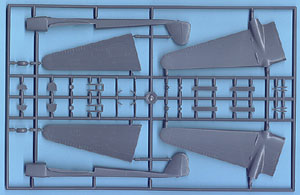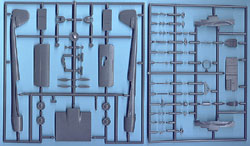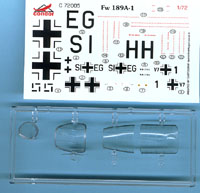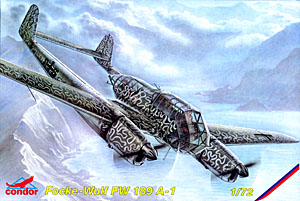History The Focke Wulf Fw 189 was a rather unique-looking aircraft designed for reconnaissance and artillery spotting. Its twin boom design allowed for a spacious cockpit section that was amply glazed, providing the crew an excellent viewing platform. The simple design resulted in excellent flight characteristics, and the Fw 189 quickly entered production in Germany, France and Czechoslovakia. Throughout the Second World War several hundred Fw 189s were produced, with most seeing service on the Eastern Front. After the war it was thought that none survived, until in the early 1990s one was found in Russia and eventually made its way to England, where it is undergoing restoration. The Kit  I've been wanting to build up the old Airfix kit of the Fw 189 for some time, but I was turned off by the amount of work needed to do this plane justice. Now with this new release from Condor, this job has suddenly become much easier. Molded in a dark gray plastic, this kit features beautiful engraved panel lines, a well-detailed cockpit, thin and clear injection canopies, and a nice decal sheet. Unlike earlier Condor releases, there is no brass or resin included in this kit, but the long-run injection technology used makes up for this. I've been wanting to build up the old Airfix kit of the Fw 189 for some time, but I was turned off by the amount of work needed to do this plane justice. Now with this new release from Condor, this job has suddenly become much easier. Molded in a dark gray plastic, this kit features beautiful engraved panel lines, a well-detailed cockpit, thin and clear injection canopies, and a nice decal sheet. Unlike earlier Condor releases, there is no brass or resin included in this kit, but the long-run injection technology used makes up for this. With all that glass surrounding the cockpit, it's good to see that there's plenty of detail present. That said, there is still room for improvement, and I would recommend the MBI book on the Fw189 for those who want to go all out with this kit. Just out of the box, though, there is sufficient detail to go around, with accurate seats & cockpit floor. Since this is the Fw 189A-1, the armament consists of single machine guns and these are well-molded and even include the shell collector tube for the upper rear gun. All of this is trapped between two fuselage halves, with a clear nose piece holding the instrument panel. This assembly will probably be a bit tricky to get together smoothly, mainly because of the total number of parts. You might also want to mask off the clear parts beforehand to make things easier. The engine/tail boom assembly includes pieces to blank off the wheel wells, although these are just blanking plates and there is no detailing present in the wells themselves. Again this is an area for the superdetailer to go wild on. The landing gear assembly itself is well done and does a good job of capturing the look of the original. The wheels are molded in right and left halves, so alignment is entirely in the builder's hands.  Fitting the booms to the wings should be straightforward, given the construction of the wing. The wing is broken down into five pieces. There is a lower center section that fits into the bottom of the fuselage. Onto this goes the two upper wing sections, butting up against the fuselage. Onto these parts fit the boom assemblies, and then the lower outer wing panels come on to finish up the wing. This arrangement makes alignment simple while also providing the strongest possible joints everywhere. The stabilizer, however, is just butt-joined to the booms and you might want to add some pins for strength. Fitting the booms to the wings should be straightforward, given the construction of the wing. The wing is broken down into five pieces. There is a lower center section that fits into the bottom of the fuselage. Onto this goes the two upper wing sections, butting up against the fuselage. Onto these parts fit the boom assemblies, and then the lower outer wing panels come on to finish up the wing. This arrangement makes alignment simple while also providing the strongest possible joints everywhere. The stabilizer, however, is just butt-joined to the booms and you might want to add some pins for strength.
The rest of the details in the kit, such as gear doors and propellers, are very well done and the only parts that I could see that would need extra work would be the bomb racks. Some light thinning of those parts is all that's needed there. Once that's all done it is time to turn to painting.  The decals included in the kit provide you with two choices. The first one is W.Nr. 2100, the Fw 189 that is currently being restored in England. This plane was flown by Lothar Mothes of 1./(H) 32 and was coded V7+IH. It was shot down on May 4, 1943 while flying out of its northern Finland base. It still carried a worn temporary white camouflage over the standard RLM 70/71 upper surfaces, with the undersides in RLM 65. The outer wingtips and a band around the rear fuselage was in yellow. The second choice is that seen on the boxtop, a rather striking example with a meandering wavy line of RLM 76 over the standard 70/71/65 camouflage. It was coded SI+EG and no other information is given. The decals included in the kit provide you with two choices. The first one is W.Nr. 2100, the Fw 189 that is currently being restored in England. This plane was flown by Lothar Mothes of 1./(H) 32 and was coded V7+IH. It was shot down on May 4, 1943 while flying out of its northern Finland base. It still carried a worn temporary white camouflage over the standard RLM 70/71 upper surfaces, with the undersides in RLM 65. The outer wingtips and a band around the rear fuselage was in yellow. The second choice is that seen on the boxtop, a rather striking example with a meandering wavy line of RLM 76 over the standard 70/71/65 camouflage. It was coded SI+EG and no other information is given.
Conclusion While the lack of resin and brass details may turn some people off on this kit, I feel that Condor has come a long way in their molding process and the result is a kit that is very buildable out of the box with little effort. The graceful lines of the Fw 189 are well captured in this kit and I'm sure that we'll be seeing several of these built up in the future. | 


 



  
    |

 I've been wanting to build up the old Airfix kit of the Fw 189 for some time, but I was turned off by the amount of work needed to do this plane justice. Now with this new release from Condor, this job has suddenly become much easier. Molded in a dark gray plastic, this kit features beautiful engraved panel lines, a well-detailed cockpit, thin and clear injection canopies, and a nice decal sheet. Unlike earlier Condor releases, there is no brass or resin included in this kit, but the long-run injection technology used makes up for this.
I've been wanting to build up the old Airfix kit of the Fw 189 for some time, but I was turned off by the amount of work needed to do this plane justice. Now with this new release from Condor, this job has suddenly become much easier. Molded in a dark gray plastic, this kit features beautiful engraved panel lines, a well-detailed cockpit, thin and clear injection canopies, and a nice decal sheet. Unlike earlier Condor releases, there is no brass or resin included in this kit, but the long-run injection technology used makes up for this. Fitting the booms to the wings should be straightforward, given the construction of the wing. The wing is broken down into five pieces. There is a lower center section that fits into the bottom of the fuselage. Onto this goes the two upper wing sections, butting up against the fuselage. Onto these parts fit the boom assemblies, and then the lower outer wing panels come on to finish up the wing. This arrangement makes alignment simple while also providing the strongest possible joints everywhere. The stabilizer, however, is just butt-joined to the booms and you might want to add some pins for strength.
Fitting the booms to the wings should be straightforward, given the construction of the wing. The wing is broken down into five pieces. There is a lower center section that fits into the bottom of the fuselage. Onto this goes the two upper wing sections, butting up against the fuselage. Onto these parts fit the boom assemblies, and then the lower outer wing panels come on to finish up the wing. This arrangement makes alignment simple while also providing the strongest possible joints everywhere. The stabilizer, however, is just butt-joined to the booms and you might want to add some pins for strength. The decals included in the kit provide you with two choices. The first one is W.Nr. 2100, the Fw 189 that is currently being restored in England. This plane was flown by Lothar Mothes of 1./(H) 32 and was coded V7+IH. It was shot down on May 4, 1943 while flying out of its northern Finland base. It still carried a worn temporary white camouflage over the standard RLM 70/71 upper surfaces, with the undersides in RLM 65. The outer wingtips and a band around the rear fuselage was in yellow. The second choice is that seen on the boxtop, a rather striking example with a meandering wavy line of RLM 76 over the standard 70/71/65 camouflage. It was coded SI+EG and no other information is given.
The decals included in the kit provide you with two choices. The first one is W.Nr. 2100, the Fw 189 that is currently being restored in England. This plane was flown by Lothar Mothes of 1./(H) 32 and was coded V7+IH. It was shot down on May 4, 1943 while flying out of its northern Finland base. It still carried a worn temporary white camouflage over the standard RLM 70/71 upper surfaces, with the undersides in RLM 65. The outer wingtips and a band around the rear fuselage was in yellow. The second choice is that seen on the boxtop, a rather striking example with a meandering wavy line of RLM 76 over the standard 70/71/65 camouflage. It was coded SI+EG and no other information is given.






